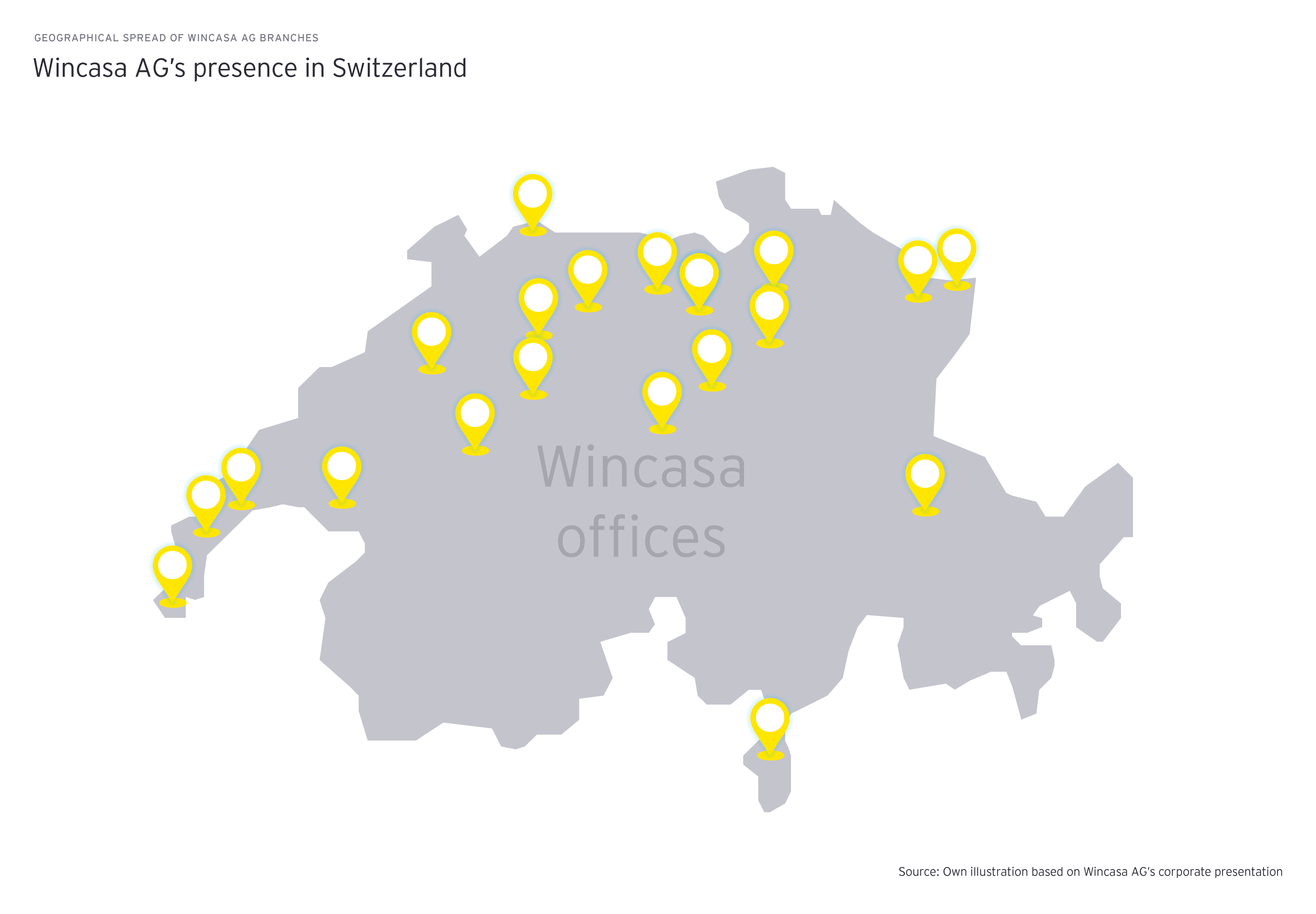
Chapter 1
Wincasa AG – an overview
Wincasa AG: one of the biggest Swiss real estate managers with a portfolio of around CHF 82 billion
What is the breakdown of Wincasa’s property portfolio? How high is the proportion of managed assets at Wincasa? What is the client breakdown?
Wincasa has been in existence since 1999, became part of the Implenia Group in 2023 and is one of the biggest real estate managers in Switzerland with CHF 82 billion assets under management. The portfolio comprises around 250,000 rental properties under management, ranging from a simple car park through to a large shopping center. Within this range we have over 70,000 residential units. Residential therefore represents around 39% of our portfolio, office units account for 22% and the remaining 39% are spread across retail and commercial (center and mixed use site management). Wincasa’s client base consists of around 40 clients with a focus on institutional customers (e.g. listed real estate companies and real estate funds, investment foundations, pension funds), corporate clients (companies from the infrastructure or telecoms sectors) and family offices. The takeover by the Implenia Group enables us to offer clients an attractive integrated portfolio of services across the entire real estate lifecycle. Our focus is on sustainability and digitization.

Geographically we are spread across 33 locations throughout Switzerland with around 1,350 staff. This country-wide network is very important for Wincasa, as it enables us to be close to rental markets, participants in these markets and the properties under management. The majority of the property portfolio we manage is located in German-speaking Switzerland. Western (French-speaking) Switzerland and canton Ticino together account for around 20% of the portfolio.


Chapter 2
Market and economic developments
Historically low residential vacancy rates: Switzerland is facing a housing shortage.
Vacancy rates in Switzerland are at a historic low and experts from federal government and the industry expect a housing shortage in the coming years. How has this happened and what do we need to do to improve matters?
The situation is complex and reflects a combination of rising demand and stagnant supply. Switzerland has had a high net immigration rate for years, with the new immigrants primarily looking for living space in urban areas and continually increasing demand there. In addition, the country has seen a steady rise in per capita land use – a trend that only seems to be weakening now. On the supply side, politicians and authorities have attempted to promote building densification in the revised Spatial Planning Act and counteract the growing dispersion of residential property. However, in practice, implementation of the act has led to a reduction in the supply of residential properties and the inward densification that had been hoped for does not seem to be working as intended due to planning objections and conditions being imposed by planning authorities. Moreover, remaining parcels of land eligible for residential construction are fragmented or have poor transport links. There have been attempts at a political level to amend the right to lodge planning objections to make it easier to complete building projects. A further way to improve supply would be to simplify the planning approval process, which is usually drawn out and comes with an ever-growing list of conditions. Finally, politicians also need to ask whether the Spatial Planning Act has achieved its aims, and if not put forward a revised version. Particularly when it comes to developing sites, the Implenia Group has had good experiences with participative processes where the groups affected by a building project are invited to and included in a dialog from the outset.
A number of Swiss cantons have already introduced rent controls and others are considering them to create affordable residential accommodation. What effect do these rental regulations, such as the LDTR (Loi sur les démolitions, transformations et rénovations de maisons d’habitation) in Geneva or the Residential Housing Promotion Act in Basel, have on the real estate market in your opinion?
These kinds of solutions lead to local and isolated phenomena. Rents may in fact be lower in places where the rent controls apply. But in neighboring, less regulated or unregulated areas, the price of residential accommodation rises disproportionately. This can be observed over decades in the Lac Léman region between Geneva and Lausanne and is backed up by statistical studies. Regulation also reduces the incentive for investors to carry out new builds or renovations. I lived in rental apartments in Geneva for several years and experienced the downsides of the lack of investment in properties at first hand. The quality of the properties deteriorated, in some cases quite severely. The Residential Housing Promotion Act recently introduced in Basel has already led to the first signs of a slowdown in investment projects, real estate transactions and a fall in property values. Of course no one will deny that the debate about affordable housing is important. The population has been hit by inflation, rising rents and health costs. Housing has become almost unaffordable in many places. As a society we need to think about future forms of working, living and transport. Do we really all have to live in prime central or urban locations? And if we do, why should it be so easy and cheap to lodge planning objections to block or prevent densification or building upwards in attractive central locations? Should we not facilitate large multi-story buildings with contemporary mixed uses in cities or large towns that are both work and residential spaces? That ideally also facilitate multi-generational living or living for disadvantaged social groups? Why isn’t it easier to convert offices into homes? If building projects like this are carefully prepared over years through a participative process and with the support of local authorities but are then rejected by voters (as happened in the city of Zurich a few years ago), we should not be surprised that there is a housing shortage. There needs to be a readiness to compromise by everyone in society and a balance needs to be struck between project models and the legal and regulatory framework.

Chapter 3
Sustainability and ESG
ESG will determine the future of real estate: Wincasa AG supports sustainability and climate targets.
According to the EY trend barometer, 91% of participants in the survey believe climate change and ESG issues will have the biggest impact on the Swiss real estate market in the next 5-10 years. In what areas do you see the greatest potential for Wincasa and the Swiss real estate industry to reach the Swiss 2050 climate targets? What has Wincasa already contributed to achieving this climate target?
At Wincasa we see significant potential to drive forward sustainability issues in the real estate sector in the following four areas: defining sustainability targets, a circular economy with a focus on sustainable materials, reporting and accurate recording of data. In terms of setting objectives it is important to include tenants, e.g. via “green leases” that create incentives to meet certain sustainability targets. It is also important to raise awareness of sustainability issues in the supply chain and add requirements and codes of conduct to supplier contracts. The question of materials applies to us mainly in maintenance and repair work, where the focus is on sustainable products and materials. The issue of sustainability in reporting is becoming ever more of a standard in the institutional area and there are already a whole host of labels, quality marks, certificates and indices that make sustainability reporting easier for investors. The final point, accurate recording of data, is the basis for comprehensive reporting. We currently see it as a major challenge to collect the data in a structured manner and above all automatically.
What role do you think the state should have in realizing sustainability objectives?
The state should fulfill four core functions with regard to environmental protection: defining targets (such as in the Paris agreement to 2050), creating legal frameworks to achieve the targets, directing the steps required and providing the infrastructure to enable a suitable energy mix to be used efficiently. To direct climate policy action, incentives such as subsidies can be used or, alternatively, the government can use taxation to nudge behavior away from things it wants to discourage. A further point is that in Switzerland implementing infrastructure projects is often made more difficult by democratic rights of objection, as illustrated by the rejection of solar parks in Canton Valais, for example. Politicians have to ask themselves whether changes to these rights are needed to meet the climate targets.
Will the inclusion of ESG criteria lead to rising yields in the medium to long term in your view? Do you see differences in how it will affect different asset classes?
We expect stricter environmental rules, as exist in the EU for example, to lead the real estate market to split into two segments: environmentally friendly “green” buildings and “non-green” buildings that do not meet the standards. The non-green buildings will be disadvantaged in transactions and raising finance and might no longer be tradable in a worst case scenario. I therefore see the issue less as one of yield, but – at least for institutional investors currently – more as a necessity to ensure their properties remain tradable and can be financed. We are optimistic that green buildings with good operating cost management can achieve an attractive yield.
The “S” in ESG is often overlooked and is difficult to quantify. What are the biggest challenges in this area at property level in your view?
The central question is what we can measure. At Wincasa we concentrate heavily on tenants. One variable that is relatively easy to measure is tenant satisfaction. Other indicators include, for example, the rental duration of tenants and identifying needs or the offerings available. The aim of our community management is to encourage tenants to interact in person and so build up a community. We do so by organizing events whose impact we can measure. Specifically, we measure how many events have been held and how high tenant satisfaction is. If we look beyond the “S” towards the “E”, other important data such as CO2 emissions by staff or by rental space become visible. Other possible criteria may include air quality or the degree of comfort inside and outside the property.
Then there is the idea of “tenants for tenants”, where tenants provide mutual support to one another. This works like a neighborhood watch and involves different generations helping and supporting each other. For example, younger tenants help older ones on technical matters, while older tenants support younger ones with tips about how to run their day-to-day lives. This policy is measurable too: what needs and offerings are there? How satisfied are the tenants with these offerings?
How do you assess the importance of a responsible person on site in this context and the resultant interactions with the users of a property?
Nowadays many properties do not have a permanent caretaker any more, as they often work in more than one property for efficiency reasons. The disappearance of a responsible person in each property is something we want to counteract with the community management we have discussed. Again we can measure how many people use this point of contact and what issues are discussed. Alongside tenants, it is also about the interaction with and between the various other stakeholders in a property or estate. In addition to the owner, who is our primary point of contact: it could for example be a retailer or event organizer who have rented a property, local authorities or suppliers and many others who all act independently of one another.
However, this works differently with tenant interest groups in shopping centers, for example. All retailers in the center usually meet the owner and property manager at least two to three times a year. Suppliers such as facility managers or security companies can also be included in these meetings. Such meeting platforms between different stakeholders lead to new specific KPIs.
In 2023 Wincasa became the first real estate provider in Switzerland to offer community management as part of its center and mixed-use site management. This is a concept familiar from co-working and co-living spaces. What service range does community management cover and how is it regarded by residents and users?
Alongside our core business, commercial building management, Wincasa also specializes in center and estate management. In this area we primarily cover the medium-sized and large shopping centers and manage mixed use estates. Examples of mixed use sites are the Prime Tower site in Zurich-Hardbrücke and the Tower site in Winterthur, where there are a large number of different use types. Overall, we manage 25 large sites with local teams responsible for commercial and technical management and marketing. Beyond this classic property management we also offer community management to create lively, multifaceted locations. That means we support and encourage personal interaction between our tenants and organize attractive on-site offers and events such as fondues, mulled wine events or public yoga sessions. From our experience we can confirm that this is a very popular offering. Tenants like to get to know other tenants and talk to them and us, even if only to discuss day-to-day problems.
How does community management contribute to your social sustainability objectives?
Our aim is “placemaking”: increasing the attractiveness of a site by establishing new meeting places, creating a communication platform and giving tenants a sense of belonging via community management. This makes a property appealing, which attracts more tenants and in turn increases its lettability and the rental duration, because people feel happy there. At the same time, we deepen the dialog over potential changes in the buildings or the immediate neighborhood, making it easier to accommodate the needs of all stakeholders. Community management can be expanded from a single property to cover the entire site or a neighborhood or city square as appropriate. Ultimately, it strengthens both the sustainability and financial resilience of the property as well as the wider site and positions it well for the future.
Community management goes much further than this, however. It is also about establishing a service offering that helps investors to achieve optimum financial performance and minimize vacancies. If it is possible to keep apartment, office and commercial tenants in their rented properties for longer, this saves money for everyone involved (including the costs of a change of tenant, from the old tenant moving out through to the integration of the new tenant).

Chapter 4
Shopping centers as an asset class
The transformation of shopping centers into places to meet and enjoy an experience
Rents for shopping centers in top locations in Swiss cities have risen by an average of 20 to 30% in the last 10 to 15 years. The increase is lower in peripheral locations, but is still 10 to 15% on average (reflecting increased demand for retail space, as well as an increase in construction and operating costs). Visitor numbers in Swiss shopping centers have also increased in the last 10 to 15 years. Around 470 million people visited Swiss shopping centers in 2010, but this increased to over 500 million by 2023. Purely based on the facts, shopping centers are therefore an attractive investment opportunity. Why did you make the deliberate decision to have some of your business in this asset class?
Wincasa decided to enter this market segment around 2010 and we have continually expanded this business segment since then. Overall we manage over 100 retail properties, including some of the biggest shopping centers in Switzerland as well as medium-sized centers. With around 2 million square meters of retail space, we are one of the largest center managers in Switzerland alongside the big retail chains Migros, Coop and Manor that own their own property estate. For example, in German-Speaking Switzerland, we manage iconic shopping centers such as Sihlcity in Zurich and Shopping Arena in St Gallen, and in western Switzerland the Centre Commerciale La Praille beside the football stadium in Geneva.
What do you see as the reason for the figures listed above in spite of the pandemic over this time horizon?
Population growth needs to be taken into account when talking about visitor numbers in shopping centers. However, the average absolute spend by consumers in francs has not returned to the pre-pandemic level in all shopping centers. From an investor perspective too, shopping centers in Switzerland have lost some of their attractiveness due to the strength of the Swiss franc since 2015, an increasing number of planning objections when renovations are planned, together with the slump in consumer spending during the pandemic and, more recently, the rise in borrowing costs. In parallel with this, online retailing has grown and now accounts for around 10 to 12% of total retail sales volumes, although growth rates are slowing. Conversely, this also means of course that nearly 90% of purchases are made in physical touch points. Hence shops and shopping centers remain the dominant form of shopping and attractive places for people to meet. Particularly against this backdrop, they will remain a relevant component in the portfolio mix of many professional investors going forward.
In this context, it is important to distinguish between peri-urban and rural areas. Do you see particular challenges here or opportunities too?
Peripheral locations outside the major cities are often difficult for shopping centers, particularly when there is a change of tenants. Clear positioning and attractiveness, as well as ease of access to the location are key. By contrast, we have urban locations like Sihlcity, effectively an urban entertainment center with additional mixed uses such as dining and entertainment and excellent public and private transport links and accessibility. This gives virtually everyone involved, i.e. owners, tenants and center managers, significantly more options to choose how the center is presented or reorient it, if necessary.
Advocates of the e-commerce industry are fond of saying: “shopping centers will be dead in 5 to 10 years”.
I have a different opinion. Historically speaking, people have a need for physical places to meet and they have always played an important role in society. Think of the forum romanum with its market squares, the zoccalos or mercados in Latin America or the souks in Arab countries. Of course, online retailing has an important role today, particularly in countries with long travel times to a shopping location. Nonetheless, physical points of sale remain dominant globally and particularly in a small country like Switzerland. As I mentioned, online retailing in Switzerland has stagnated at below 15% of overall retail sales volumes. Modern shopping centers use both analogue and digital channels, i.e. the majority of retailers are using the omni-channel strategy. However, just at the moment shopping centers are experiencing a revival. They are very popular meeting and shopping areas if they are able, in addition to satisfying basic shopping needs, to offer attractive services such as entertainment and convenience.
What in your view is the most important point to remember in such transformations?
The center has to position itself clearly. A purely local shopping center in a village or small town where everyone goes shopping can be very attractive if it has the right mix of consumer goods. In addition the condition of the buildings, accessibility and active communication with end consumers plays an important role.
Are there special KPIs for the shopping center segment? What KPIs are measured?
The most important KPIs are revenues, visitor frequency, size or composition of the shopping basket and evaluation of the visitor segments who come by public transport or car. Shopping centers may conduct surveys to find this out or it may also be possible, depending on the shopping center, to capture shopping baskets via apps, record the routes taken by visitors in the center or find out which shops they actually buy in. This data can then be used to work out what action to take and how to communicate with customers. In the other segments of office, commercial or residential this kind of KPI tracking is only possible to a limited degree.

Chapter 5
Digitization and artificial intelligence
Game changer AI: understanding the transformative role of AI and integrating it in business models.
According to the 2024 EY trend barometer, survey participants expect artificial intelligence (AI) to play an important role in shaping future business models. Around a third of investors are already working on integrating artificial intelligence in their business models. How has AI changed your business model at Wincasa in recent years?
AI will be a game changer in future. But what do I see as the problem with AI at the moment? Before it can be used, we need to establish a variety of guidelines and principles. These include an established technology infrastructure, consistent data and compliance with the Data Protection Act. Equally, AI technologies must first reach a degree of maturity that enables them to work error-free even for complex requirements.
In our Wincasa2025 strategy launched in 2019, we decided to bring about an extensive transformation of the company at four levels: technology, process, organization and culture. The technological transformation objectives include a cloud-first strategy, the establishment of digital portals for our most important stakeholders such as owners, tenants, suppliers and staff and the integration of core and ancillary systems via the integration hub. Complying with the Data Protection Act and streamlining databases was tackled in stages. We are also paper-free, i.e. we are fully digitized and can already work independent of location. At the same time we are updating our operating model in the core business of real estate management by building a denser branch network, rigorously dividing up the management of properties and tenants into B2C and B2B and professionalizing marketing and performance measurement. We need the appropriate personality and skills profiles to ensure such fundamental changes can be successfully implemented. In 2018 we began working in small groups across all hierarchies to define seven cultural values as the basis for the transformation. This transformation will be completed at all levels by the end of 2025.
IT is something of a patchwork in the real estate industry. What are the requirements for a modern software architecture?
It is true to say that there is no one uniform software package that covers everything for a real estate service provider with a broad service offering. However, a modern enterprise architecture takes account of this fact. The integration hub mentioned earlier combined with digital portals and well-structured databases offer the opportunity to build a modern technology platform that is capable of being developed.
In what areas are you already using AI in your day-to-day business?
At the moment we are only using AI in a limited and specific way. As soon as you process sensitive data through what is often an international cloud infrastructure, you may be in breach of the Data Protection Act. Caution is therefore needed, and in a highly professional compliance environment with institutional investors, as we have at Wincasa, the use of AI is severely limited. To explore efficiencies and test technologies, we have used data protection-compliant AI in a number of different cases.
Our conclusion: the technology is still developing and prone to errors. It also often needs full access to large datasets that derive from different sources. As soon as the problem becomes too complex or information needs to be obtained from the property owner, these AI technologies cannot find the solution by themselves and human interaction is needed. Therefore an established digital infrastructure and full access to the data and solution sources are definitely needed. However, this will exist in the next 5 to 10 years.
The potential for productivity and information gains through AI is naturally huge. In the real estate sector there could be significant leaps forward in the areas of predictive analysis and forecasting with regard to tenant behavior, optimization of maintenance and investment cycles as well as new demand for additional services. Anyone who has access to the infrastructure and data will have a significant competitive advantage in future.
You said before that a large proportion of AI services such as OpenAI are not fully developed yet. Where do you see the biggest dangers?
There are dangers in the uncertainty about the counterparty. Who is sending me an email? Who am I speaking to? Is the content or a request real or just a deep fake created by AI? There is also the question of trust and reliability. As a real estate manager or bookkeeper authorized to make payments, I have to ensure that a payment order I have received is real, and that I do not execute an incorrect payment due to fraud or error. Even today this is already part of a careful review process, but such reviews will become much more complex in terms of the ability and capability of people to assess them in future.
You played an important part in championing and driving forward the digitization of Wincasa.
a) What three tips would you give an established company in the real estate sector that wants to build up a digitization strategy?
Digitization is part of a transformation strategy. Introducing digitization changes processes and these in turn change the way the organization is structured and require the right attitude by people inside the company (corporate culture) as well as outside the company (ecosystem). My three tips are based on this.
Don’t underestimate. A technology project and transformation strategy are extremely complex, time-intensive and cost-intensive.
Be persistent and courageous. You need to be brave, since you face a large number of unknown variables. These include constantly developing technologies, one’s own initial lack of knowledge and skills, changing client requirements as well as the geopolitical and monetary policy environment, to name a few. At the same time the process will give rise to resistance that needs to be handled properly (stakeholder management) and not every introduction of a new tool or process is successful the first time. Persistence and belief in the ability to implement change is needed.
Be visionary and patient. When implementing a transformation and digitization strategy it takes time for it to be fully understood and accepted by all relevant stakeholders. Particularly in an environment of varied professional profiles, institutional clients and high compliance and data protection requirements. You need a clear vision, an idea of where you want to get to, patience and confidence that you will manage the implementation.
We have now successfully implemented two thirds of our Wincasa2025 strategy and will push forward the last third of the way together with Implenia. The first synergies have already been realized and we are expanding our service range with attractive joint offerings for our clients. Our clients and shareholders believe in us, support us and recognize, in spite of some challenges, the benefits that will become even clearer in future.
Thank you for the conversation today.
Summary
Wincasa AG, owned by the Implenia Group, manages a large Swiss property portfolio and focuses on digitization and sustainability. Oliver Hofmann (Wincasa CEO) highlights a need for political reforms and new building projects to tackle Switzerland’s housing shortage. Rent controls can adversely impact investment. Mr. Hofmann sees ESG as the most important future issue, with a key role for the state. AI still faces challenges before it becomes a game changer. Community management is deployed to enhance social sustainability. Shopping centers remain relevant despite online shopping and the pandemic. Hofmann recommends patience and a clear vision when implementing digitization strategies.
Acknowledgements
We thank Annabell Nachbaur and Simon Schmid for their valuable contribution to this article.


